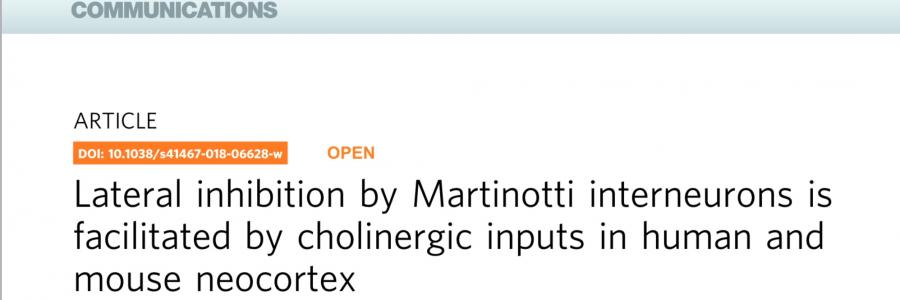
Joshua Obermayer and Tim Heistek publish their study on cholinergic regulation of lateral inhibition in human and mouse cortex in Nature Communications
Joshua Obermayer and Tim Heistek in the lab of Huib Mansvelder reveal rapid effects of neuromodulator acetylcholine on human and mouse cortical neuronal networks. The research focused on the question how the flow of information through cortical microcircuits is controlled by acetylcholine produced in the basal forebrain, a process that is affected in neurodegenerative disorders such as Alzheimer’s disease.
We become aware of our thoughts, experiences, feelings by activity of neurons in the cortex of our brain. In the cortex, excitatory and inhibitory neurons work together to process incoming information from our senses and other brain areas. Different types of inhibitory interneurons can be part of so-called motifs of cortical information flow, and form feedforward and feedback loops.
One of those motifs is lateral inhibition between the most abundant excitatory cell types in the cortex, the pyramidal neurons. It is thought that active pyramidal cells can emphasize their message in the cortex by silencing neighboring neurons through lateral inhibition. Neuromodulators such as acetylcholine are produced in other parts of the brain, but can affect the function of the cortex as ‘master switches’ that enable information processing by cortical networks and put them in an alert state.
It is generally assumed that acetylcholine acts at a slow time scale of minutes to hours. However, Mansvelder’s team shows that acetylcholine can act on much faster time scales, of seconds or tens of seconds. These time scales are much more relevant for cognitive processes. The research team investigated how flow of information between pyramidal neurons either via parvalbumin-positive interneurons or somatostatin-positive Martinotti cells is controlled by acetylcholine. By activating cholinergic fibers with optogenetics, the team found that acetylcholine strongly facilitated lateral inhibition via Martinotti cells by increasing their activity within tens of milliseconds, but left lateral inhibition via parvalbumin interneurons untouched.
The researchers went on to show in a collaboration with the neurosurgery department at the Amsterdam UMC (VU medical center) that these mechanisms also take place in the human brain. Most of what we know about the function of neurons comes from research on laboratory animals. Much less is known about function of human cortical neurons. Only few laboratories worldwide successfully collaborate with local neurosurgery departments to study living human cortical microcircuits.
Regulation of lateral inhibition via Martinotti cells is conserved in human cortex, with similar mechanisms underlying the increase in human Martinotti cell function as in mouse cortex. Activity of Martinotti cells, their role in cortical information flow and regulation by acetylcholine was never studied before in human brain. The findings show that acetylcholine acts on a time scale within a second to alter information flow in the cortex between pyramidal neurons, which is similar in mouse and human brain.
Publication: Lateral inhibition by Martinotti interneurons is facilitated by cholinergic inputs in human and mouse neocortex, Nature Communications Oct 5 2018. https://rdcu.be/8yHk